Hurricane Florence lashed the coast of North and South Carolina. PHOTOS
- Florence made landfall a few miles east of Wilmington, N.C.
- The South Carolina Dept. of Transportation offers a map with webcams showing traffic conditions on local freeways.
- Utility providers have told customers in the Carolinas to expect prolonged power outages for millions of people.
- Track the storm with our map.
- Share via
Florence’s death toll rises to 11 as storm shifts inland, bringing ‘epic’ rainfall and record floods
With a plodding pace belying still-unspent fury, an increasingly deadly Tropical Storm Florence pushed deeper into the Carolinas on Saturday, inundating homes, toppling trees and pushing rivers far beyond their banks as rescuers in boats and helicopters rushed to keep pace.
Six new fatalities were reported Saturday, bringing the storm toll to 11. Nearly a million people, mainly in North Carolina, were without power a day after Florence made landfall a few miles northeast of Wilmington, N.C., as a howling Category 1 hurricane.
By midafternoon Saturday, the massive storm was crawling westward at about 3 mph, unleashing havoc as it went. Inland, the peril grew; on the coast, storm surge warnings were discontinued Saturday.
- Share via
For President Trump, a strong response to Hurricane Florence may be key to political future
Even before Hurricane Florence made landfall in North Carolina, President Trump was kicking up a storm of controversy.
Outraged over criticism of his handling of Hurricane Maria last year in Puerto Rico, he falsely blamed Democrats for inflating the death toll to 3,000. Discounting an academic study produced by George Washington University and accepted by the island territory’s local government, Trump tweeted that the number had arisen “like magic.”
The barrage of angry tweets guarantees that his handling of the current storm, which is still battering North and South Carolina, will be under the microscope. Eleven people had been reported dead by Saturday evening, and hundreds needed to be rescued from flooded homes.
- Share via
Knocked sideways by Florence, New Bern rushes to get back on its feet
All through the night as Hurricane Florence began hammering this city near the North Carolina coast, Paul Canady’s phone buzzed and beeped with messages from members of Christ Episcopal Church, where he serves as rector.
A collapsed tree leaned against a nearby house where a husband and wife live. A family huddled in their attic to escape the rising floodwaters. There was no electricity anywhere.
But by Saturday morning, the water was receding, the rain had abated and Canady’s flock appeared safe. So he drove downtown to see how the church itself had weathered the storm.
- Share via
A sigh of relief in Greenville, N.C.
- Share via
Here are the latest Florence rainfall predictions
- Share via
Flood warning issued for Cape Fear River in North Carolina
In Fayetteville, N.C., which is about 90 miles inland from the coast, the Cape Fear River is forecast to rise 50 feet by Tuesday morning (from 12 feet to 62 feet). The National Weather Center says flood stage is 35 feet. Says Twitter user Jack Sillin @JackSillin: “So think about where you would stand on the banks usually, then go up 4-5 stories!”
- Share via
Hurricane Florence meanders through Carolinas, unhurried in its terror
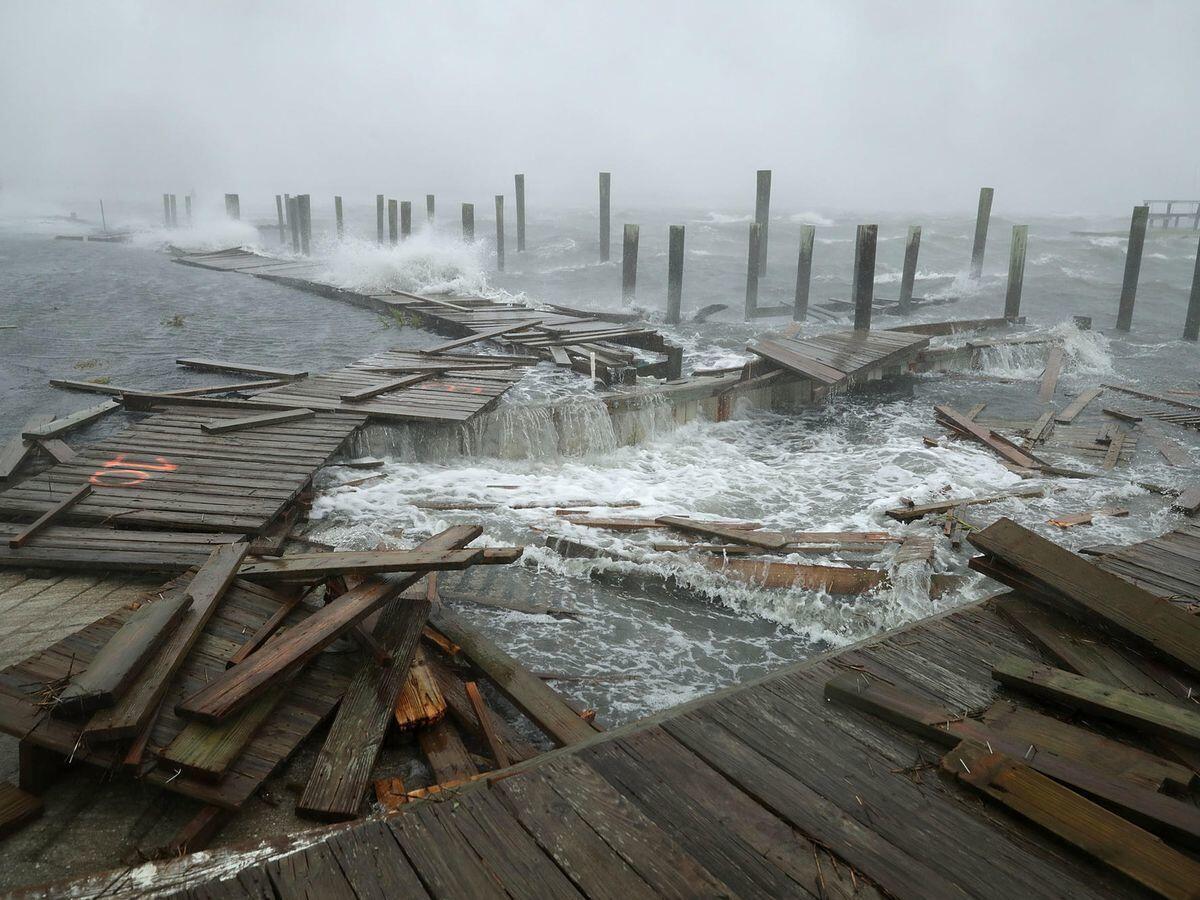
Ocean water swamped streets and swept into buildings, while powerful winds sent a tree crashing into a home, killing a mother and her infant.
But for all its strength, Hurricane Florence was a slow-motion disaster. Deliberate and hulking as it moved Friday throughout the Carolinas, it was unhurried in its terror.
“The storm is going to continue its violent grind across our state for days,” North Carolina Gov. Roy Cooper said, calling it “an uninvited brute that doesn’t want to leave.”
- Share via
Yes, hurricane damage is getting worse. But that’s largely because there’s more stuff to damage
In 1960, roughly 845,000 people lived in the 24 counties along the Carolina coast.
By 2000, the number had grown to more than 1.5 million as the demand for beach living and ocean views continued to rise.
The coastal population today tops 2 million.
The development boom persisted despite warnings that global warming would continue to raise sea levels and could increase the intensity of storms. As in many places with strong Republican traditions, the issue of climate change remains highly contentious in both North Carolina and South Carolina.
But you don’t have to trust the science of climate change to see the obvious: With more development along the coast, there is more to destroy when a hurricane pays a visit.
- Share via
A family rescued as their apartment soaks
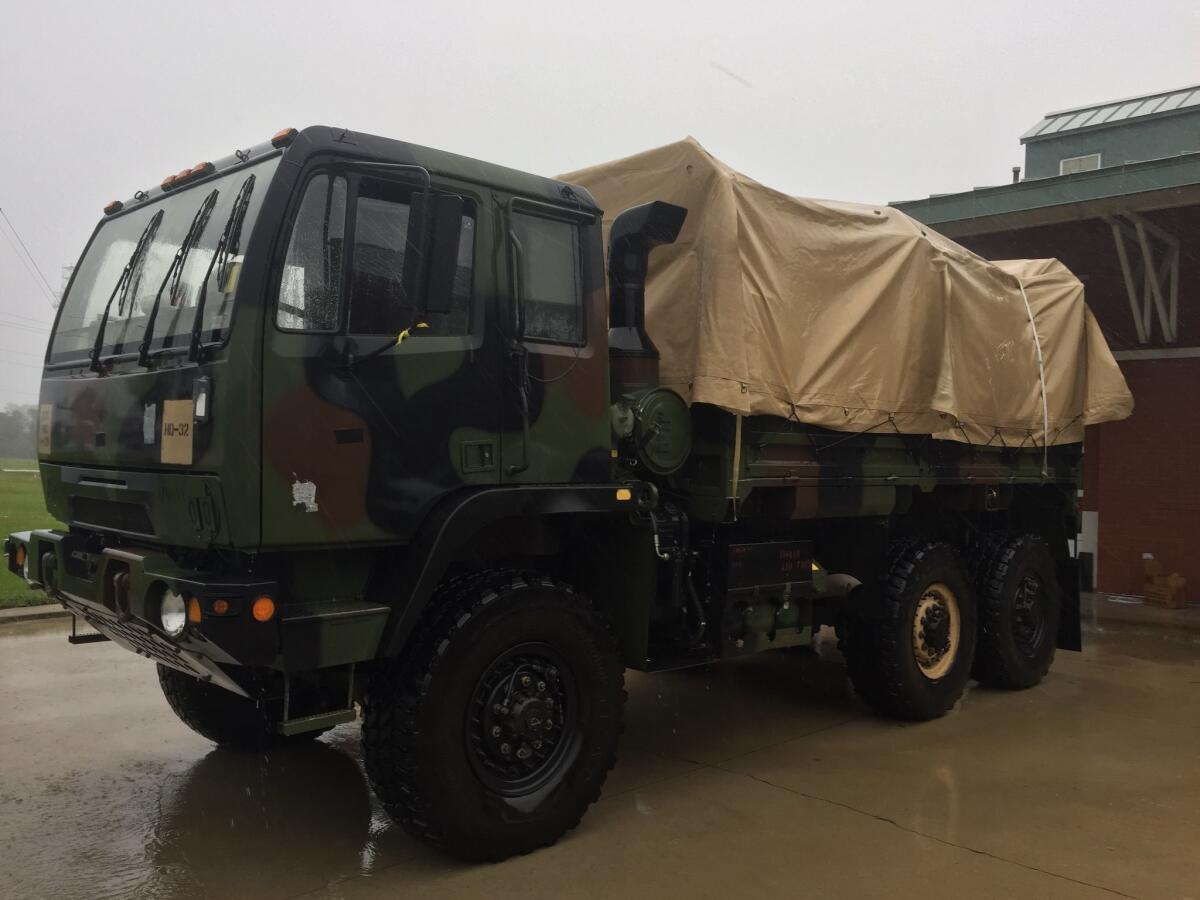
“Two adults, two children.” The call arrived after Sgt. Nick Muhar’s unit had already rescued more than 80 people threatened by Hurricane Florence.
The North Carolina National Guard truck pulled out of the New Bern, N.C., fire station and sped through flooded streets. The cab was heated like a sauna to keep the windshield from fogging up. A can of chewing tobacco rested on the dashboard.
Muhar’s truck arrived at a brick apartment building where the overflowing Neuse River swamped a playground and lapped at front doors. Inside, a family scrambled to gather their belongings. The electricity had gone out, and a knee-high waterline was etched into the wall.
A little girl in a sweatshirt and rain boots, both pink, emerged all smiles. The guardsmen lifted her into the back of the truck.
“That’s a lot of water, isn’t it? Did you leave the sink on?” Sgt. Matt Locke joked. The girl giggled and nodded.
A couple and a small boy then loaded into the truck with backpacks and plastic bags of food they had salvaged.
The guardsmen fanned out across the apartment complex looking for more holdouts who needed a ride.
Two women, one elderly with a cane, accepted the offer. Most turned them down. Reginald Nobles, 52, had no interest in hunkering down in a shelter. “I don’t like living with nobody,” he said.
Nearby, toppled trash cans and garbage strewn like seaweed showed how high the water had reached. The guardsmen would likely return. The tide was expected to rise at night.
- Share via
A mother and infant reported dead from Hurricane Florence in Wilmington, N.C.
- Share via
Duke Energy warns: Power could be out for weeks after Hurricane Florence
- Share via
Residents in riverfront city wait out the storm at home
The roads into New Bern, N.C., are littered with branches. Sheets of rain pelt the ground, overwhelming drainage ditches. Metal signs rattle in the wind.
At a historic home on a corner near downtown, Debbie Edwards, 64, and her sister eye the water outside through taped-up windows, while passing the time playing gin rummy.
They cleared out storm grates in the morning, hoping to prevent the rising water from reaching up and over the steps of the house that has been in the family for four decades.
So far, they feel lucky, having made it through last night when their street became a river.
“It was like, oh, oceanfront property!” Edwards said.
“We’ve had hurricanes our entire life,” she added. “Nothing like this.”
- Share via
A message from North Carolina: ‘Pray 4 us’
- Share via
Hurricane Maria drove him from Puerto Rico -- and straight into the path of Hurricane Florence
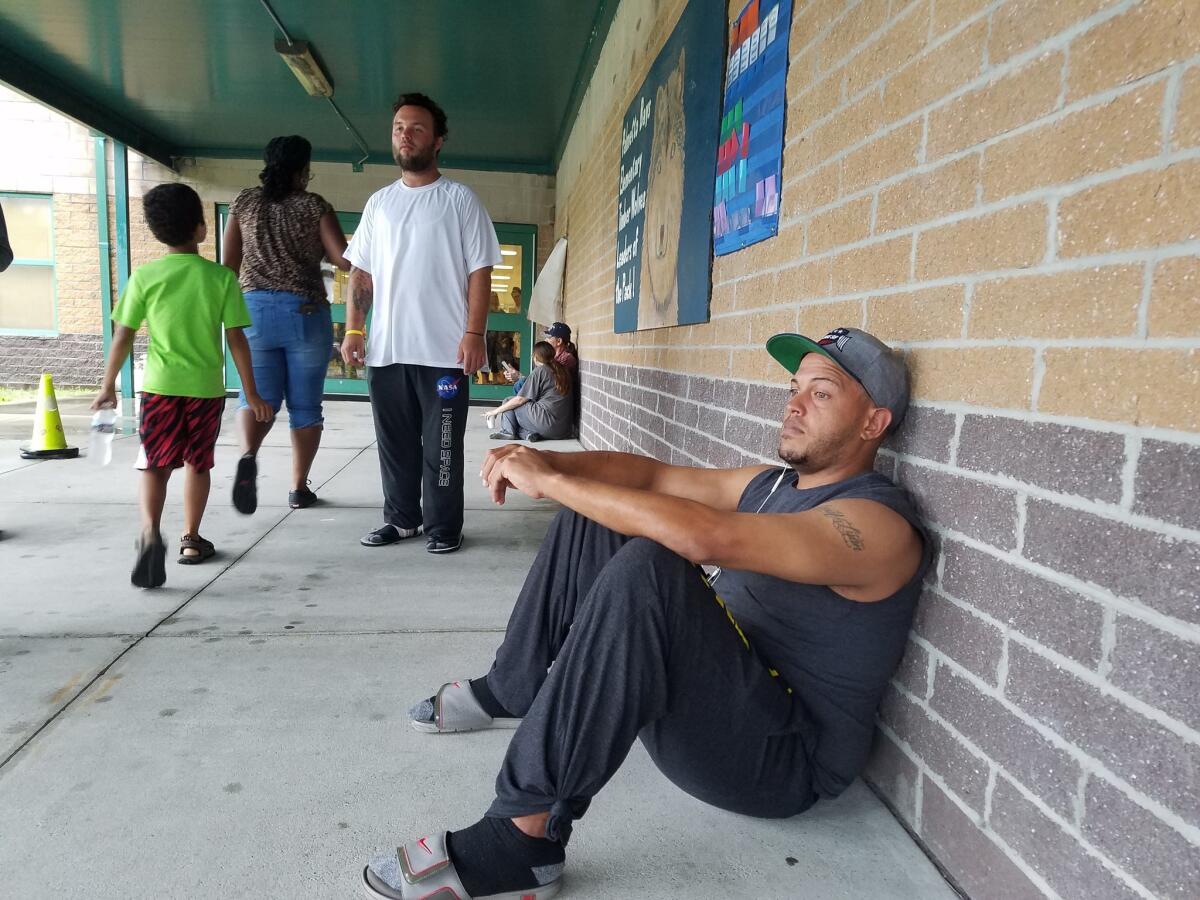
Hurricane Florence drove Edwin Sanchez, 33, from his apartment and job in Myrtle Beach, S.C., where he’s a housekeeper for an oceanfront resort, to a shelter at an elementary school on Friday.
He moved here seven months ago after Hurricane Maria destroyed his home in San Juan, Puerto Rico, and his livelihood as a chef and bartender. The month before, Hurricane Irma drove his ex-wife to leave the island for Pennsylvania with their 10-year-old daughter, Jenniflyan.
He had called them the day before to say he was subject to mandatory evacuation and was at the shelter, which had already filled, 480 people hoping their homes would survive storm surge and inland flooding. More evacuees showed up Friday, and staff sent them to a handful of other nearby shelters, which were also rapidly filling.
PHOTOS: Hurricane Florence batters the Carolinas
Four local hospitals had evacuated, and some of the ill were being cared for by two nurses the American Red Cross had stationed at the school. School staff came to clean and cook three meals a day.
Evacuees were a mix of young families, immigrant workers and elderly couples with vacation homes.
“At least we’re good, we’ve got a place to stay, food. There are many people outside who’ve got it worse,” Sanchez said.
He tried to flee to a nearby shelter during Hurricane Maria, but it was full. He spent more than a month living on the streets of San Juan with just a backpack of possessions, begging for help from emergency officials at the convention center, at times wanting to die.
“Nobody helped,” he recalled, his gray-green eyes tearing. Finally, a staffing company on the mainland offered to pay his way to Myrtle Beach, and Sanchez decided to start a new life. He found an apartment close enough to walk to his job at Wyndham Ocean Boulevard and Shore Crest Vacation Villas.
As he sat in Palmetto Bay Elementary School’s outdoor walkway in sweats and flip flops, trying to keep his cigarette alive in waves of windblown rain, Sanchez reflected on the storms that drove him from his home and family. They also taught him to do without, to become resilient, to hope, he said. And because of that, when he looked at the rain pelting the schoolyard and surrounding forest of spindly pines, he saw not just impending destruction, but recovery.
“Maybe I can help and get a little work,” he said.
- Share via
In a town in North Carolina, the water is rising and no one knows how high it will go
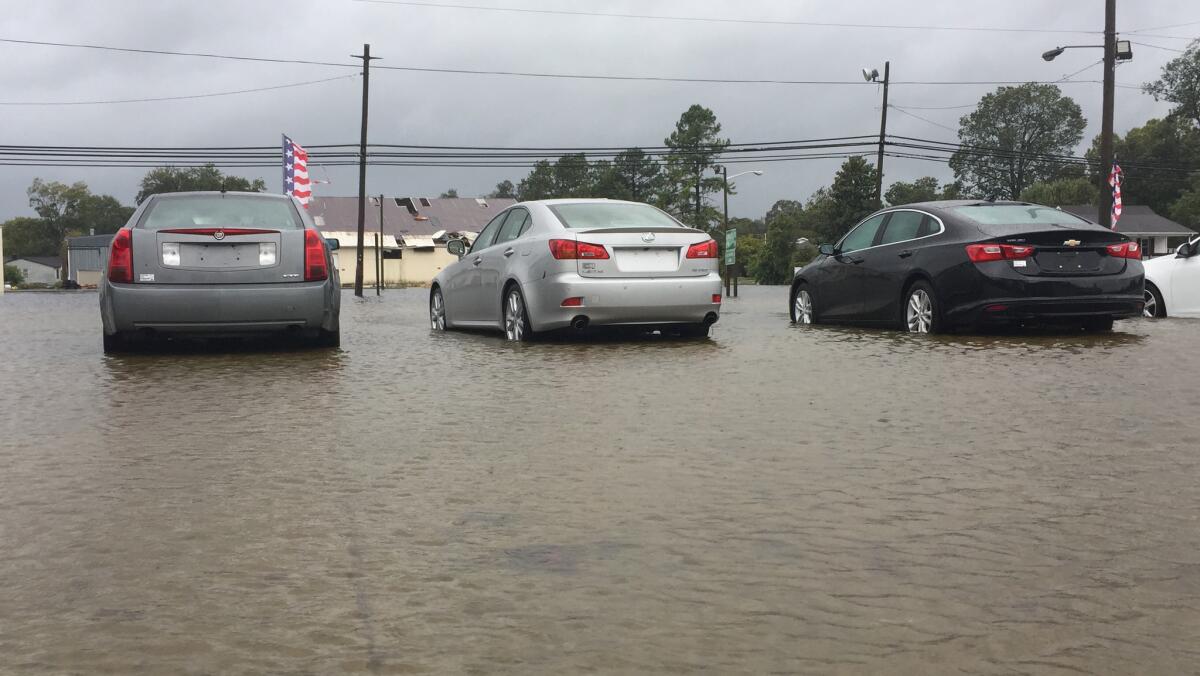
In the town of Washington, N.C., flood waters swamped an intersection early Friday, making it impassable for everyone except a few with pickup trucks.
The metal roof of a warehouse across the street was shredded by the wind. A neighborhood grocery store flooded, costing the owner some of his produce. At a used car lot on the corner, two cars were damaged as the water rose.
“I can live with [losing] two cars,” said the owner, Steve Griffin, 48, who lives nearby in Bath. “I can’t live with many more.”
The wind picked up and small waves of water continued rolling in. Although flooding isn’t unusual in Washington, “this is higher than it’s ever been in this lot,” he said.
Gregory Sams, 60, a retired security guard, left his second floor apartment to look for a store selling cigarettes but couldn’t find any. Like everyone else, he had no idea how much higher the water would get.
“Your guess is as good as mine,” he said as a light rain fell. “If it keeps raining it’s going to get higher.”
- Share via
National Hurricane Center: ‘Life-threatening’ flood danger will linger for days
- Share via
Rescue workers on the move in James City, N.C.
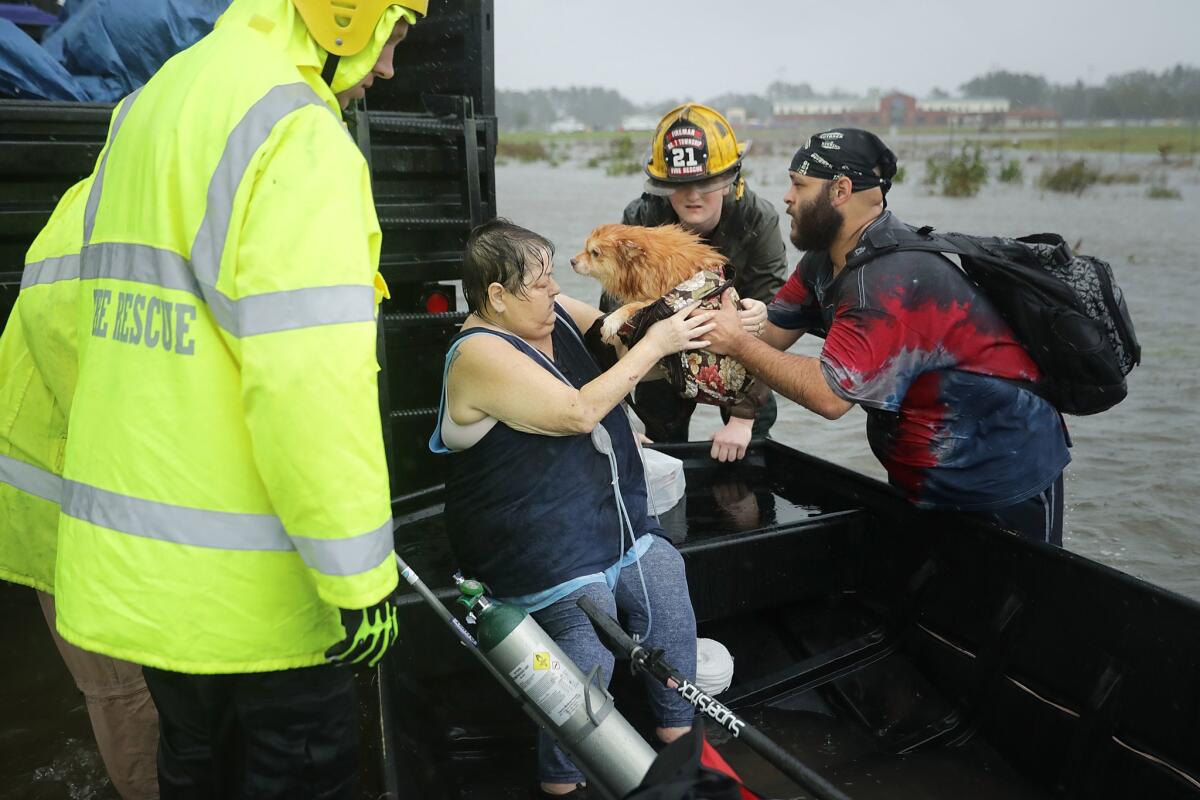
- Share via
Webcams on the front lines offer a closer look
The South Carolina Department of Transportation offers a map with webcams showing traffic conditions on local freeways.
This webcam offers a view from the Rehoboth Beach boardwalk in Delaware.
Here’s a view of Myrtle Beach, S.C.
This webcam is placed at Frying Pan Tower, a Coast Guard Light Station 34 miles off North Carolina.
Lifehacker has a camera at Cape Fear, N.C.
- Share via
As Hurricane Florence approaches, environmental disasters in North Carolina loom
Whipping winds and surging ocean waters won’t be the only threats from Hurricane Florence, which is expected to make landfall in North Carolina on Friday.
Rain and rising floodwaters could swamp coal ash basins and hog waste lagoons, washing the byproduct of the state’s industries into rivers and lakes. Environmentalists warn of toxic chemicals, bacteria and other dangers.
If that happens, some of the damage from this natural disaster would have a distinctly man-made component, echoing problems from previous storms.
- Share via
As rain and wind empty out a North Carolina town, there’s always one place to ride out a hurricane — Waffle House
As the rain and wind started to bear down on Wilmington before dusk, and all the big-box stores, restaurants and gas stations were dark, the lights were still on at the Waffle House.
“We’re not closing unless it gets unsafe — if the hurricane pulls off the roof or breaks the glass,” said Matt, a Waffle House employee who stood under an awning outside the Market Street location to greet a stream of families and loners, locals and out-of-towners.
As usual, cooks cracked eggs and slung hash browns on the grill top. Servers poured coffee with a “There you go, sweetie.”
- Share via
As the leading edge of Florence hits the coast, the Carolinas brace for monster hurricane
The leading edge of Hurricane Florence lashed the coast of the Carolinas on Thursday as the weakened but widening storm edged closer to the Southeastern U.S., bearing dangerous winds and drenching rains.
Florence’s sustained winds fell to 110 mph overnight, dropping it back to a Category 2 storm. But the still-powerful storm also grew even larger, visible from outer space as an enormous circular mass set to envelop the coastline, with tropical-storm-force winds extending nearly 200 miles ahead of Florence’s center.
“Please hear my message — we cannot underestimate this storm,” said North Carolina Gov. Roy Cooper, speaking Thursday at a briefing in Raleigh, the capital. He warned of “battering winds and relentless rains that will last for days,” with storm surges up to 13 feet, reaching the second stories of buildings in vulnerable coastal areas.
- Share via
Trump falsely says Puerto Rico’s official hurricane death tally is inflated by Democrats
President Trump on Thursday falsely accused Democrats of inflating Puerto Rico’s death toll from hurricanes Maria and Irma, insisting the total is much smaller than various studies have found — a contention that provoked widespread outrage even as the East Coast braced for a massive new storm.
The president’s rejection of the U.S. island’s official tally that nearly 3,000 people died after last year’s devastating hurricanes, and his suggestion that the toll wasn’t much greater than 18 deaths, was one of the most prominent examples to date of Trump’s instincts to deny accepted reality when he perceives it as criticism and to counter with conspiracy theories.
His statements in back-to-back morning tweets came while millions of Americans were anxiously watching the path of Hurricane Florence as it headed toward the Carolinas. Trump for days has been focusing on federal preparations for that storm, recognizing that his administration’s response will be a key test of competency ahead of the November elections.
- Share via
Rainfall predictions for Hurricane Florence